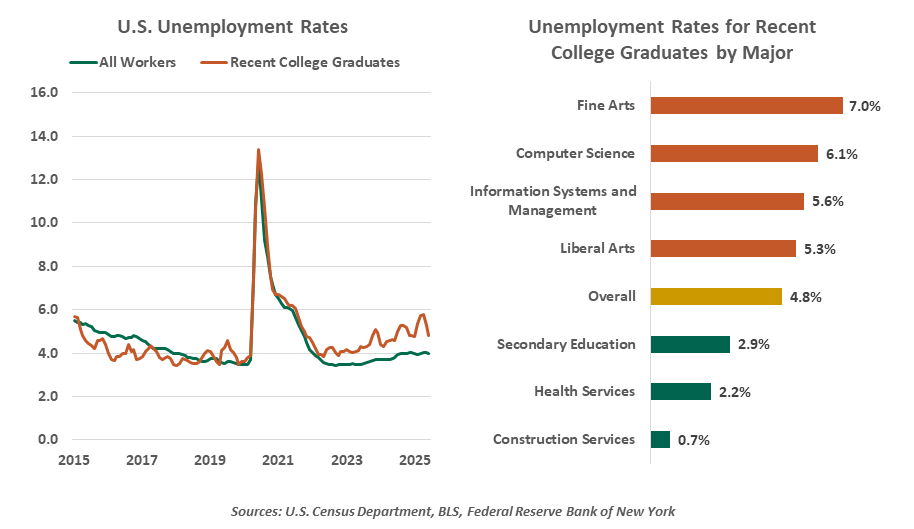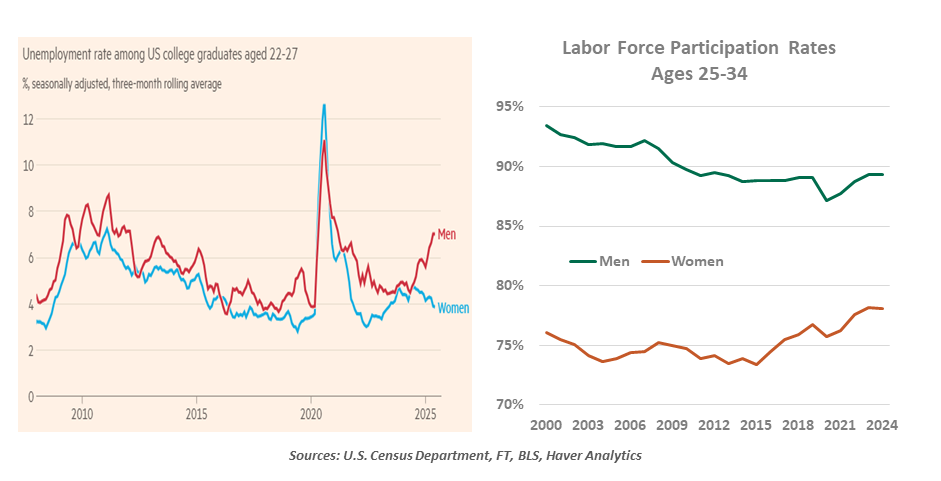- Who We Serve
- What We Do
- About Us
- Insights & Research
- Who We Serve
- What We Do
- About Us
- Insights & Research
Failure To Launch
Younger workers are facing difficult employment prospects.
By Carl Tannenbaum
I was the subject of an intervention during my vacation last month. My daughter provided a harsh critique: she told me that my lack of familiarity with podcasts and artificial intelligence (AI) was not acceptable. If I didn’t get with those programs, she said, I risked becoming even more irrelevant than I already was.
To help, my daughter pushed me in the proper directions. An hour-long tutorial began a more extensive exploration of AI models, and some podcast recommendations increased my familiarity with the genre. During the voyage of discovery that followed, the two channels converged on a particular theme: rising evidence that young people in the United States are struggling. The economic and social implications of this trend are profound.
Employment news has been under the microscope lately, amid large revisions to the data and a pending change of leadership at the Bureau of Labor Statistics. But long before the events of early August, analysts had been focusing on rising levels of unemployment among recent (ages 22-27) college graduates. Once well below the overall level, joblessness within this cohort is now 20% higher. If we focus on those who have graduated in the last two years, unemployment is over 6%.

More than 40% of recent college graduates who are working are underemployed, meaning that they hold jobs that do not require a degree. Interestingly, those with credentials in fields that used to be in high demand are facing some of the worst hiring conditions.
Cyclical factors explain some of these developments. Recession risk has been elevated for the past three years, causing companies to watch headcount levels. Layoff rates have been stable, suggesting that new hiring has been the main avenue of conservatism.
AI is affecting hiring rates for college graduates.
A bigger challenge facing new graduates appears to be the presence and promise of artificial intelligence (AI). Morgan Stanley estimates that investment in AI software and infrastructure will total nearly $3 trillion over the next four years. The four largest technology companies (Meta, Alphabet, Amazon and Microsoft) are investing almost $100 billion per quarter in AI, betting on sustained demand. Firms are pressing for more productivity, not more personnel.
Among the things that AI does well are reading, research, summarization and basic analysis. These are exactly the functions that junior professionals have traditionally performed. Learning from those entry-level tasks positions service workers to progress to higher-order responsibilities; if these are automated, it becomes harder for both employees and employers to define career paths. These issues are covered well in the Plain English podcast entitled “The Job Market for Young Grads Is Flashing Red.”
The adoption of new technology typically goes through phases. Innovators take to it quickly, while others take more time. AI’s use of natural language, which invites novices to dig in, may accelerate the process. Aimless experimentation may transition more quickly to productivity.
In recent decades, younger service workers have been advantaged by increments of technology. Spreadsheets, the internet and modern modes of communication were native to them; applying these avenues in the workplace allowed them to contribute positively, and early. But educational institutions have been slow to incorporate AI into their curricula. Quite the opposite, in fact: using AI has been viewed as cheating in many corners. As companies move at pace to introduce AI toolkits, many college graduates are facing a knowledge deficit.
Articles covering the frustrations of new degree holders often include questions about the value of college. Tuition has escalated by 50% more than the rate of general inflation over the past 20 years, and an increasing fraction of jobs created within the economy do not require a baccalaureate. Research from the Federal Reserve Bank of Cleveland suggests that the wage premium for college graduates has diminished slightly over that interval, although it remains high.

That data, however, predates the advent of AI. We may not know for some time whether the economics of higher education have been disrupted by the arrival of large language models. A paradigm change may be afoot.
Digging beneath the surface of these developments reveals a sub-plot that is also getting considerable attention: young men seem to be struggling disproportionately, extending a trend that has been in place for two decades. Only 42% of undergraduates are male; 47% of young (25-34 year old) women have college degrees, as opposed only 37% of men. Rates of addiction, suicide and incarceration are many times higher for young men than they are for young women. AI is likely to provide a further challenge, clouding paths to prosperity and exacerbating the sense of malaise that many are struggling with.
Young men are falling further behind.
Debate over the root causes of these trends is active, with a number of theories advanced. Single-parent households, deficiencies in early childhood education and changing societal norms are among the factors cited. I listened to a range of podcasts on the topic; there is considerable divergence on the relative importance of these elements.
To address the young male employment gap, some have proposed increasing apprenticeship programs in the trades, roles in which men are overrepresented and where worker shortages are apparent. This model works well in a number of European countries. Others focus on improving persistence in both high school and college, which would raise levels of enrollment and degree-holding.
My daughter’s radical candor did not help me achieve the state of relaxation that I was seeking during my week off. But it was a call to action, which I appreciated. The challenges facing recent college graduates should be a call to action for policymakers. An intervention may be needed to effect change.
Related Articles
Read Past Articles
Meet Our Team

Carl R. Tannenbaum
Chief Economist

Ryan James Boyle
Chief U.S. Economist

Vaibhav Tandon
Chief International Economist
Subscribe to Publications on Economic Trends & Insights
Gain insight into economic developments and our latest forecasts for the United States.
Information is not intended to be and should not be construed as an offer, solicitation or recommendation with respect to any transaction and should not be treated as legal advice, investment advice or tax advice. Under no circumstances should you rely upon this information as a substitute for obtaining specific legal or tax advice from your own professional legal or tax advisors. Information is subject to change based on market or other conditions and is not intended to influence your investment decisions.
© 2025 Northern Trust Corporation. Head Office: 50 South La Salle Street, Chicago, Illinois 60603 U.S.A. Incorporated with limited liability in the U.S. Products and services provided by subsidiaries of Northern Trust Corporation may vary in different markets and are offered in accordance with local regulation. For legal and regulatory information about individual market offices, visit northerntrust.com/terms-and-conditions.